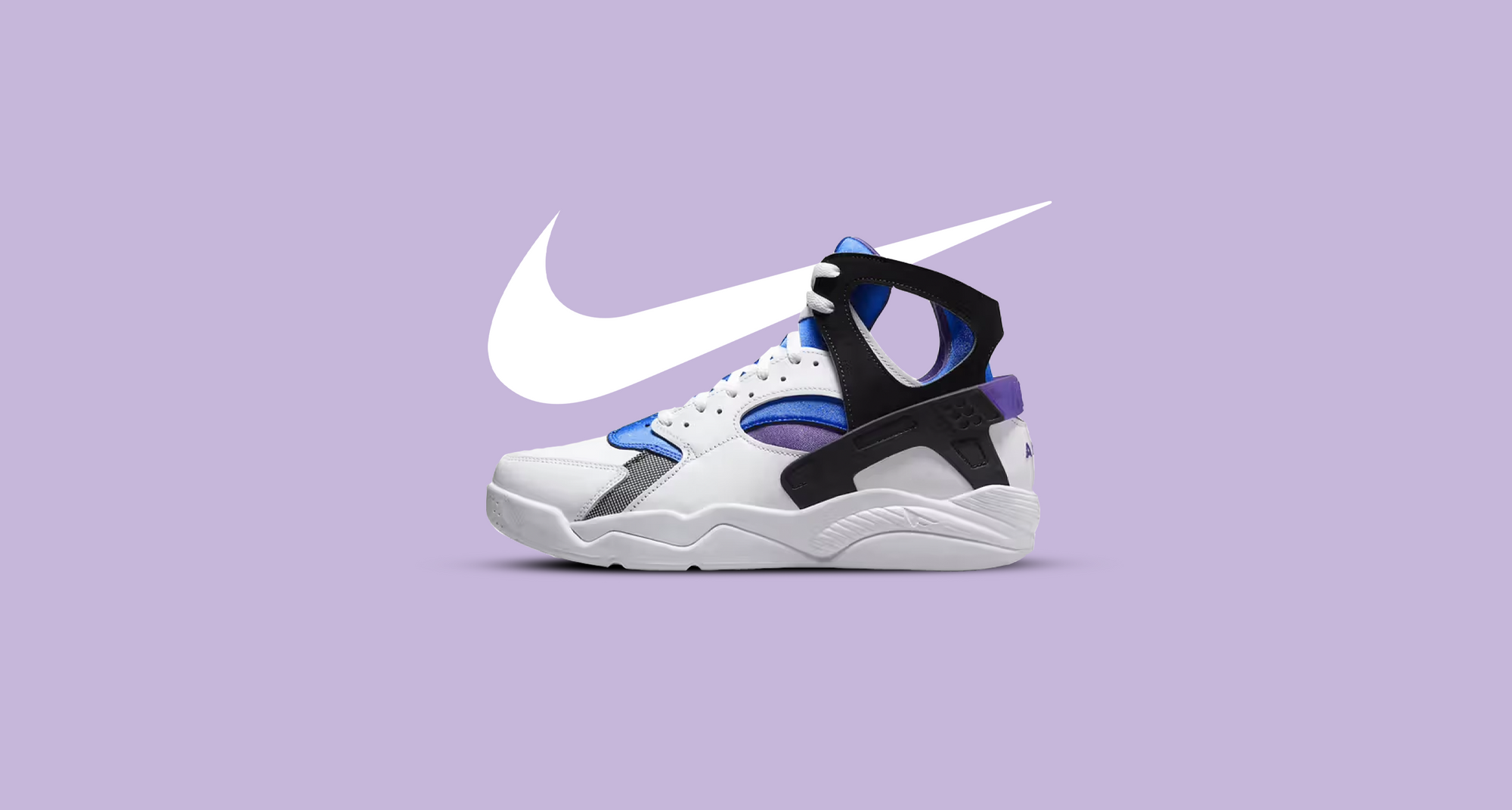
March 10, 2023 by Joey Birch
A Closer Look at the Nike Air Flight Huarache
The Nike Air Huarache has had a long and illustrious history with an ever-evolving response from sneaker fans across the globe. Whether it’s seen as the ‘cheeky Nando’s lad’ shoe or a lowkey collaborative masterpiece with the likes of Stüssy, first released in 2000, it’s a silhouette that in some way plays a role in every person's life.

Originally released in 1991, a year after the iconic Air Max 90, the Nike Air Huarache was designed by the legendary Nike designer - Tinker Hatfield. Taking initial inspiration from a water skiing boot, referenced within the neoprene boot on the sneaker, early iterations of the design process showcased the signature visible Air Unit as found on the AM90 in addition to the rubber heel clip wrapping around the ankle of the shoe in conjunction with a cage-like structure supporting the mid foot.
The official model featured several of these design elements, however, Hatfield ended up opting for a concealed Air Unit within the midsole. As well as the intriguing upper, the outsole also brought a new idea of what a sneaker could look like from a performance standpoint. The ethos behind Air Max is to generate notoriety for alternate sporting outlets, those that weren’t played on the court for instance with the introduction and domination of the Air Jordan line which at the time had just released its fifth silhouette. It’s this aforementioned experimentation found in the Air Max line which was also seen within additional projects - this time the Air Huarache.

Featuring a rugged outsole, the sneaker was made with marathon running in mind with a lightweight construction supported by a form-hugging liner and framework. Named after a Mexican slipper, the shoe was made to be worn for long distances. To ensure that the sneaker was perfect for long-distance running, Nike sold the first 5000 pairs to a selection of marathon runners who provided largely positive feedback.
However, the response from the general public wasn’t so kind. Akin to the reputation of the Air Huarache today, the sneaker was met with mixed reactions when it first arrived on shelves due to its outlandish design and distinct lack of Nike branding with only a small ‘Nike Air’ tab featured on the tongue and ‘Nike Air’ on the outsole.

Despite its mixed response throughout its 32-year tenure, the Nike Air Huarache has remained a consistent fan favourite for many, so much so that it was also developed into additional variants each with its own distinct details including the: Nike Air Flight Huarache (1992), Nike Air Huarache International (1992), Nike Air Trainer Huarache (1992), Nike Air Tech Challenge Huarache (1992), Nike Air Huarache Light (1993), Nike Air Trainer Huarache ’94 (1994), Nike Air Zoom Huarache 2K4 (2004), Nike Huarache Free (2011) - amongst others.
Kickstarting the cross-pollination of the Nike Air Huarache, was the Nike Air Flight Huarache. Released in 1992, the Flights were co-created by Tinker Hatfield and Eric Avar, the mastermind behind some of the biggest basketball models of all time including the Air Foamposite, Kobe 6 and Air Penny silhouettes. Throughout the mid-80s - early 90s, bulkier footwear was standard on the hardwood court as players opted for heavy padding and cushioned midsoles over the likes of Converse which had been worn previously.

The Nike Air Huarache aimed to revolutionise basketball footwear, maintaining the lightweight construction of the original Huarache, blending it with a form-fitting, supportive, outer frame. In the words of the original advert for the sneaker: “the game hasn’t changed, but the shoe has”.

Featuring a closer overall design to the original sketches of the Nike Air Huarache by Hatfield in 1991, the sneaker featured the usual neoprene sock inner overlaid with leather panelling. The key difference with the ‘Flight’ version of the shoe was the increased length of the tongue as well as the frame seen on the original being extended up to support the ankle while still allowing space for free movement; a feature that was highly appreciated on the prior model.

Debuted by the ‘Fab Five’ a team of basketball players from the University of Michigan who played in the NCAA, consisting of Chris Webber, Jalen Rose, Juwan Howard, Jimmy King and Ray Jackson, the sneaker immediately set a precedent for what it aimed to do on the court by shaking up the status quo. Despite not matching the Michigan kit, the Fab Five played in the Nike Air Huarache Flight regardless, creating yet another timeless moment in basketball and sneaker history.
The question is, will the cult classic silhouette have the same impact in 2023? With rumours circling that the basketball shoe is returning after last being retroed in 2014, that question may be answered soon.
We’ve seen Nike looking back at its retro catalogue, specifically its basketball offerings, with rose-tinted lenses lately with the return of the Air Jordan 1 ‘Chicago’ as well as the recent Air Jordan 3 ‘White Cement’.

The return of the Nike Air Huarache Flight in its original purple, blue and white colourway provides another opportunity for a new audience of sneaker enthusiasts to experience the sneakers that created moments in history. With the ever-changing landscape of modern sneaker culture, it’s hard to tell how they’ll be received.
For the latest on Nike, including the best Air Jordan 3s of all time and the upcoming Corteiz x Nike Air Max 95, keep it Kick Game.